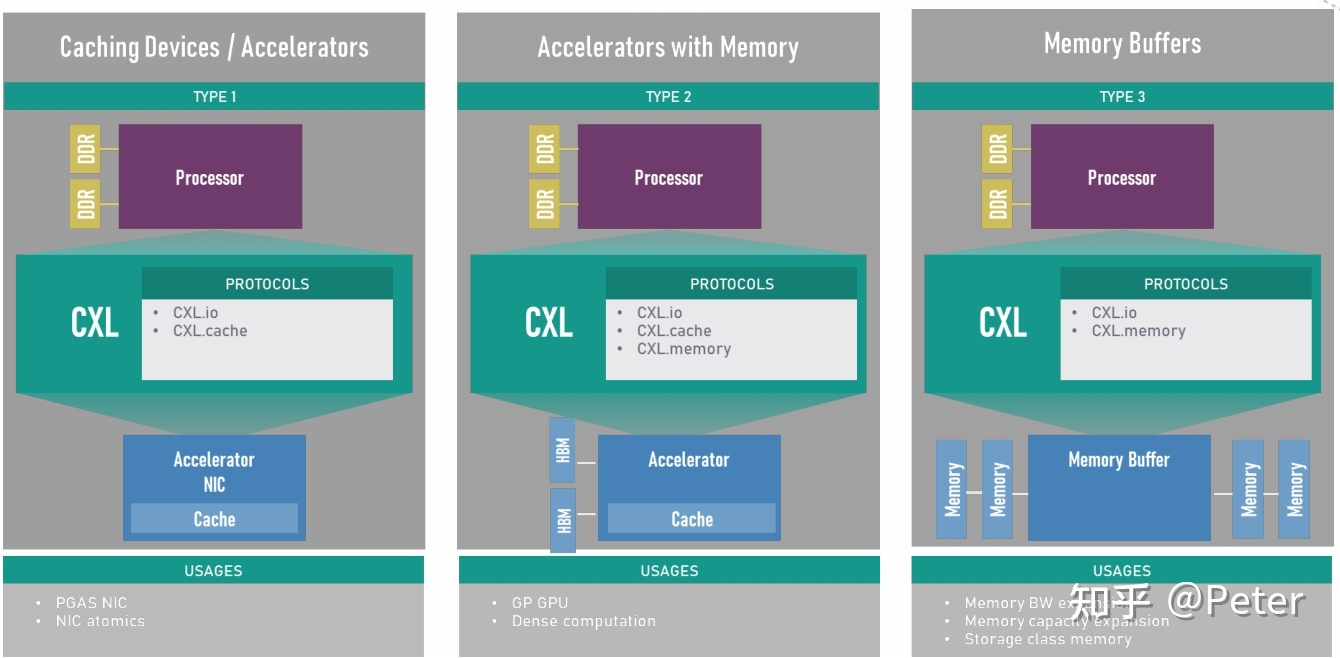Compute Express Link™ (CXL™)
1、CXL内存的延迟
根据基于 CXL 的大内存池化 - Macan的文章 - 知乎的数据:
- 控制器直连内存延迟 ~100ns
- 访问NUMA链路内存 ~ 180ns
- 访问CXL内存延迟 ~170-250ns
2、CXL的内容和用途
CXL在PCIe 5.0的基础上复用三种类型的协议,分别 CXL.io,CXL.cache,CXL.memory。
- CXL.io 用来 发现,配置,寄存器访问、中断等。
- CXL.cache当设备访问处理器内存用来cache来自处理器的内存。
- CXL.memory 用来处理来自处理器对设备内部的内存的访问。
CXL在CPU和设备之间维护了一致性的内存空间。
CXL主要有三种应用场景。
- TYPE 1是常用于网卡这类高速缓存设备,它通常只支持io和cache的协议。
- TYPE 2是常见于GPU, AI等应用的内存加速器,它支持io,cahce,memory三种协议。
- TYPE 3通常是作为内存缓冲器,常用作内存带宽或者是容量的扩展,它支持io和memory两种协议。
不管哪种类型的设备,都要支持io的协议,因为CXL.io 是用来 发现,配置,寄存器访问、中断等。我们要配置,访问设备的寄存器,所以要支持io。

以上内容来自于 CXL简介 - 追寻内心的宁静的文章 - 知乎
3、CXL设备类型
结合来自维基的内容 Compute Express Link
- Type 1 (CXL.io and CXL.cache) – specialised accelerators (such as smart NIC) with no local memory. Devices rely on coherent access to host CPU memory.
- Type 2 (CXL.io, CXL.cache and CXL.mem) – general-purpose accelerators (GPU, ASIC or FPGA) with high-performance GDDR or HBM local memory. Devices can coherently access host CPU's memory and/or provide coherent or non-coherent access to device local memory from the host CPU.
- Type 3 (CXL.io and CXL.mem) – memory expansion boards and persistent memory. Devices provide host CPU with low-latency access to local DRAM or byte-addressible non-volatile storage.
Type 2 devices implement two memory coherence modes, managed by device driver. In device bias mode, device directly accesses local memory and no caching is performed by the CPU; in host bias mode, the host CPU's cache controller handles all access to device memory. Coherence mode can be set individually for each 4 KB page, stored in a translation table in local memory of Type 2 devices. Unlike other CPU-to-CPU memory coherency protocols, this arrangement only requires the host CPU memory controller to implement the cache agent; such asymmetric approach reduces implementation complexity and reduces latency.
简要概括(以下把host memory称为内存,把device local memory称为缓存):
- 类型1,没有本地缓存的专用加速器(例如智能网卡)。设备可以对主机CPU内存进行一致性访问
- 类型2,具有高性能GDDR或者HBM的通用加速器(GPU/ASIC/FPGA),设备可以对host cpu' memory进行一致性访问 和/或者 从host cpu对设备缓存进行 一致性/非一致性的 访问
- 类型3,内存扩展和持久内存,设备可以为host cpu提供DRAM和非易失性存储的低延迟访问
类型2实现了两种存储一致性模型
- device bais mode,设备直接访问本地存储,host cpu不做缓存
- host bias mode,host cpu的缓存控制器负责对设备本地存储的所有访问
可以为每个4 KB页面单独设置一致性模式,存储在类型2设备本地存储的转换表中。与其他 CPU 到 CPU 内存一致性协议不同,这种安排只需要主机 CPU 内存控制器来实现缓存代理;这种不对称的方法降低了实现的复杂性并减少了延迟。
4、其他链接
1、Compute Express Link 标准介绍
2、聊一聊CXL - 夏晶晶的文章 - 知乎
3、基于PCIe 5.0的CXL是什么? - 老狼的文章 - 知乎
4、



 浙公网安备 33010602011771号
浙公网安备 33010602011771号